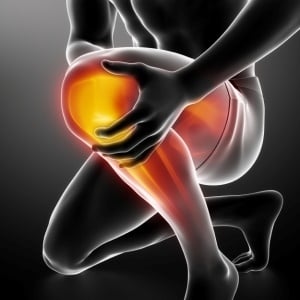
Knee pain is something many people contend with at some point in their lives, and there are many reasons for getting pain in this vital joint. When visiting a doctor, he/she will look at your medical history and perform a physical exam.
Blood tests may be done to test for arthritis, and x-rays, bone scans or MRI's may be done to determine loss or damage to cartilage or bone.
Knee pain can be acute, in which case the cause is probably due to an accident or sports injury, or chronic, when we have to look at an underlying medical condition such as arthritis.
Being overweight is also a common cause of knee pain.
Identify your knee pain then look at the probable cause:
1. Chronic knee pain
This is often due to a previous injury, but is associated with several underlying medical conditions.
Osteoarthritis is the commonest type. It is an age-related condition, sometimes called “wear and tear arthritis”, and is caused by gradual degeneration of the joint cartilage. The pain varies from day to day, is often worse in the mornings, and eventually leads to a stiff joint.
Rheumatoid arthritis is a destructive auto-immune disease, often involving both knee joints. Acute flare-ups alternate with quiescent periods. Pain, stiffness & swelling eventually lead to loss of mobility and a destroyed, deformed joint.
Gout: see under "acute pain" above or read more about the causes of gout.
Chondromalacia patellae describes a condition of pain under the kneecap, due to mild arthritis of the patella. It is common in young women. Pain is worse after sitting, or with rising from the chair or going up stairs, and patients report a sensation of grating under the kneecap. Read how patellae femoral syndrome causes knee pain
Tumours: malignant tumours of bone (like osteogenic sarcoma) can cause pain and swelling near the knee. This must be excluded in a young patient who has no history of sport injury or any underlying medical condition.
2. Acute knee pain
Sudden knee pain is usually due to an injury, the common ones being:
Tendon injuries: Tendons attach muscle to bone, and are prone to injury, especially in athletes. Sudden rupture – partial or complete – will cause pain, and prevent normal movement of the joint. More commonly, inflammation sets in, especially in the quadriceps and patellar tendons (tendonitis)
Ligament injuries: The knee has two ligaments inside the joint (Anterior Cruciate Ligament and Posterior Cruciate Ligament) and two outside (Medial Collateral Ligament and Lateral Collateral Ligament), connecting the femur and tibia, and stabilising the joint. Tearing any of the these ligaments often results from contact sports, or a heavy fall, and causes immediate pain, which is worse on walking or bending the knee. Damage to the internal ligaments may cause the knee to give way when weight is put on the leg.
Meniscus injuries: The meniscus is a cartilage “cushion” inside the joint. A tear of the meniscus can cause pain, worsening over 24 to 48 hours. The tear may lift a piece of the cartilage off which then flaps between the knee bones (like a bucket-handle): this can cause locking of the joint, preventing full straightening of the leg. Alternatively, a piece of the meniscus can break off, and move around in the joint space, interfering with normal movement. Old or repeated injuries can lead to degeneration of the meniscus.
Knee dislocation: This commonly affects the kneecap, and is easily seen. Dislocation may become a recurrent problem.
Gout: Although this is a chronic underlying disorder, an attack of gout occurs suddenly, causing intense pain and swelling which can last up to two weeks, then clear, leaving normal joint movement. Read more about the causes of gout.
Bursitis: This is inflammation of the fluid-filled sacs outside the joint, over which the tendons slide. Commonly the bursa at the front of the knee (pre-patellar bursa) is affected, causing pain when kneeling.
Iliotibial band: Athletes, especially runners, are prone to this disorder, in which the ligament from the hip bone to the tibia is tight, and chafes against the outer femur
Osgood-Schlatter disease is an overuse problem found mainly in athletic teenagers, and can affect one or both knees.
Septic arthritis can follow an injury. In addition to pain, the patient will be ill and feverish.
Read more:
Physical therapy can be as good as knee surgery
Exercises and stretches to help heal knee pain




 Publications
Publications
 Partners
Partners















